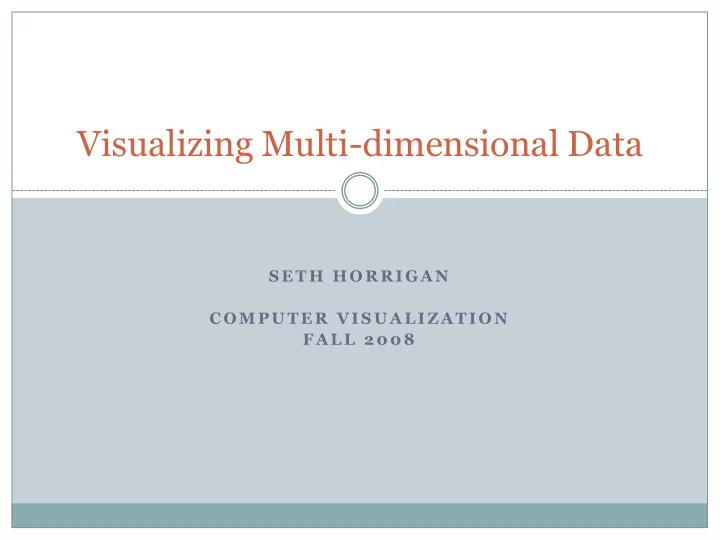

Visualizing Multi-dimensional Data S E T H H O R R I G A N C O M P U T E R V I S U A L I Z A T I O N F A L L 2 0 0 8
Motivation Multi-dimensional datasets are common Digital cameras Wall-street stocks Motor vehicles Cellular telephones A mixture of interval, ordinal, and nominal data can be visualized well using a table
Motivation
Motivation Questionnaire surveys produce special dataset Interval Ordinal Usually compared only within-variable
Motivation
Motivation Need a good way to relate variables to each other Need a good way to visualize multiple ordinal variables
Shortcomings Ordinal variables are usually graphed against interval variables
Shortcomings Graphing ordinal against ordinal does not work well
Shortcomings Regression lines only help a little
Shortcomings Summing helps, but really encodes different data
Initial Concept Introduce random jitter
Initial Concept Multi-dimensional matrix Allow continuous rotation from viewpoint to viewpoint
Initial Concept ScatterDice N. Elmqvist, P. Dragicevic, J.-D. Fekete. Rolling the Dice: Multidimensional Visual Exploration using Scatterplot Matrix Navigation. In IEEE Transactions on Visualization and Computer Graphics (Proc. InfoVis 2008) , to appear, 2008. (Best paper award)
Previous Work Geometrically transformed displays W. S. Cleveland. Visualizing Data. Hobart Press, 1993. Iconic displays H. Chernoff. Using faces to represent points in k – dimensional space graphically. Journal of the American Statistical Association, 68:361 – 368, 1973. Dense pixel displays D. A. Keim and H.-P. Kriegel. VisDB: Database exploration using multidimensional visualization. IEEE Computer Graphics and Applications, 14(5):40 – 49, Sept. 1994. Dimensional stacked displays J. LeBlanc, M. O. Ward, and N. Wittels. Exploring N-dimensional databases. In Proceedings of the IEEE Conference on Visualization, pages 230 – 237, 1990.
Previous Work Overview of methods D. A. Keim. Information visualization and visual data mining. IEEE Transactions on Visualization and Computer Graphics, 8(1):1 – 8, 2002. Encoding variables J. Bertin, Graphics and Graphic Information Processing, de Gruyter, Berlin, 1981.
Current Concept Color + Position + Size + Small multiples
Current Concept Much more difficult to interpret how the individual data points aggregate to the whole Allow many dimensions of data to be visualized using position Also considering how to specifically enhance a scatterplot to convey the data
Technical Challenges Fitting many variables into small space Design through prototyping Determining data encoding (colors? texture?) Reference previous research, experimentation Maintaining part-to-whole relationships With each design, record what information is conveyed or lost Building prototype Use existing knowledge and work in Prefuse and Flare
Milestones 10/31 - 5 other solution concepts 11/5 - Determine how, if at all to include interval data 11/5 - Create storyboards 11/10 - Determine color or other encoding Create legend 11/20 - Build automatic optimal layout 11/25 - Design and build interaction 12/1 - Build Attribute-explorer style filters 12/10 - Create final presentation and paper
Recommend
More recommend